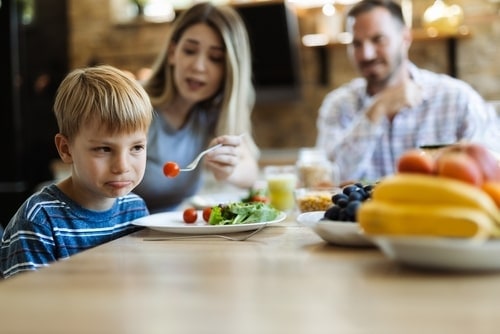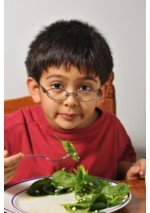Your picky eater: Tips for coping with a child who rejects food

Are you struggling with a picky eater? If so, you are in good company. Throughout the world, it’s common for young children to reject new foods (a phenomenon called “neophobia”). It’s also normal for youngsters to show an enhanced sensitivity to the bitter notes in food, and some kids are hypersensitive to certain flavors, odors, and textures. But this doesn’t mean you’re doomed to endure stress and strife at the dinner table. In fact, research suggests that the best approach is to reduce conflicts and bad feelings, and encourage to kids to develop positive feelings about food.

Here are some suggestions for getting there – evidence-based tips for dealing constructively with a picky eater.
Understand the biology of picky eating
When children refuse to eat nutritious foods, it can be very frustrating. It might make us worry, too, and this can lead us to adopt negative tactics that make the situation worse (Emmett et al 2018).
To avoid this trap, it’s helpful to understand the biology of picky eating. Kids aren’t acting out on a random whim. They are guided by a natural reluctance to eat foods that are unfamiliar, bitter, or sour. In addition, some individuals inherit genes that magnify these tendencies, and many picky eaters are extremely attuned to the sensory properties of food, including texture, consistency, and odor.
In the evolutionary past, such “pickiness” may have helped children avoid ingesting items that are dangerous or harmful. Nowadays? Being neophobic and picky might seem like a bad deal – a barrier to achieving a balanced diet. But if we become more savvy to how our children differ from us, we’ll be in a better position to find solutions. For more information, see my article about the biology of the picky eater.
Avoid coercion and pressure tactics
Insisting that children try to eat…Continuing to pressure them even after they say they aren’t hungry…Offering bribes…Expressing disapproval or disappointment…Inducing guilt or shame…Parents may resort to these tactics out of desperation, but they don’t seem to improve children’s eating habits. On the contrary, they just teach children to associate mealtimes with conflict and stress, which can fuel even more trouble (Jansen et al 2017; Daniels 2019; Thorsteinsdottir et al 2022).
For example, when researchers tracked the development of more than 4800 children in the Netherlands, they found that kids who were pressured to eat at age 4 tended to get fussier about eating by age 6 – even after controlling for their initial levels of picky eating (Jansen et al 2017).
Other studies have reported that pressuring kids to eat is linked with reduced intake of fruits and vegetables (e.g., Warkentin et al 2020; Brown et al 2008), as well as with negative attitudes towards foods that last into adulthood (e.g., Ellis et al 2016; Batsell et al 2002). In a recent study, researchers questioned more than 19,000 adults – all self-identified “picky eaters” – about their childhood struggles with food. The overriding verdict from these adults was that parental coercion had not helped them overcome food aversions or broaden their diets (Kim et al 2022).

Is this terribly surprising? As parents, we can forgive ourselves for feeling irritated by or worried about picky eating. But we have to realize that kids regard certain foods as threatening, disgusting, or otherwise aversive. If we try to force it – if our kids perceive us as compelling them to eat – we risk intensifying those negative feelings even more. If they are anxious about eating certain things, they simply become more anxious. And if we bribe them with rewards? We’re simply confirming a child’s belief that eating the target food is an ordeal.
Moreover, there’s something fundamentally demotivating about frequent, persistent prompts to eat. What if someone served you a bowl of soup, and then asked you to “finish your soup, please” every 60 seconds? In a small experiment on preschoolers, researchers found that kids subjected to this treatment consumed less soup overall than did kids who were left alone. And these kids were almost twice as likely to make negative comments about the soup (Galloway et al 2006).
Take a long-term approach to familiarizing your child with new food
It’s one of the best-documented strategies for expanding your child’s diet: Give your child the chance to learn about a new food gradually, through repeated encounters.
For young infants learning to eat solids, this might mean presenting the same, new food every day – for 8-10 days straight – before babies start to accept it. In experiments, most babies have needed to experience such daily “taste tests” in order to lose their initial dislike for the food in question. (Read more about it in this Parenting Science article about starting solids.)
Repeated tastings are also helpful for preschoolers and older children (e.g., Nekitsing et al 2018; Karagiannaki et al 2021), but of course part of the problem is that many kids refuse even to taste a new food. If that’s your situation, don’t be too pushy. Instead, try these methods:
- Read picture books together – books that show children how a food is farmed, transported, sold, and cooked. When parents took this approach with their toddlers (18-24 months) – every day for two weeks – their kids went on to eat more of the target food (Heath et al 2014; Owen et al 2018).
- Allow kids to touch and play with a new food. In studies of both babies and preschoolers, children tasted more of a vegetable after they were given multiple opportunities to touch, smell, and manipulate it (Dazeley and Houston-Price 2015; Coulthard and Seely 2017).
- Use placemats that feature images of new vegetables you’d like your child to try. Researchers tried this with preschoolers, and it was helpful. After being exposed to vegetable-themed placements for a couple of weeks, kids were more inclined to eat the vegetables depicted (Rioux et al 2018).
Harness the power of positive social cues
Throughout the animal kingdom, social cues matter. Juveniles are more likely to eat foods if they see another individual eating them, and human children follow this same trend.
For example, experimental studies suggest that young children are more likely to accept a new food if they see an adult eating it (Adessi et al 2005), especially if the adult demonstrator appears to be enjoying the food (Barthomeuf et al 2012; Frazier et al 2012).
The same is true for peer demonstrators – except that the effect is even more powerful. All things being equal, kids are more persuaded to try another food if they see that another child likes it (Frazier et al 2012; Sharps et al 2022; Bevelander et al 2012).
So we can encourage kids to try new foods – and develop healthy eating habits – by acting as good role models. But watch out, because the power of social cues can work both ways. Kids are more likely to reject a new food if they see others doing so.
Eat meals together, as a family
Maybe it’s about social cues, or maybe it’s about the benefits of structured meals – getting kids into the rhythm of eating at a certain time and place every day. Either way, studies suggest that young children are less likely to refuse foods that are served up as part of a family meal (Powell et al 2017; Verhage et al 2018).
Encourage your picky eater to learn about food by shopping, cooking, and gardening
We’ve seen that pictures, instructional books, and hands-on play are helpful. There’s also evidence that kids benefit from participating in the collection and preparation of food. For example, researchers have found that children increase their willingness to taste new foods if they accompany their parents on shopping trips to buy the ingredients (Allirot et al 2018), or get involved with cooking (Garcia 2020). And while the evidence is mixed, there are hints that kids become a bit more inclined to eat vegetables after participating in vegetable gardening (Savoie-Roskos et al 2017; Varman et al 2021).
Is your child suspicious of complicated fare? Offer plain, simply-prepared meals

As I explain in my article about the biology of picky eaters, it’s normal for children to be resistant to trying new foods, and some kids are especially sensitive to textures and odors. These kids feel a sense of vigilance about what they eat, and they want to be able to look things over before they commit.
In addition, I’ve noticed that some kids aren’t picky eaters so much as they are purists. They’ll eat all sorts of food as long as it’s plain and simply prepared. What they don’t trust are foods hidden in sauces and gravies – or mashed together with a lot of other things.
So it’s worthwhile to try a minimalist approach to food prep. It may help reduce anxiety and mistrust, and possibly boost intake. When researchers reviewed a decade of research on getting preschoolers to eat their vegetables, they found that kids tended to eat more when the veggies were offered in plain form (Nekitsing et al 2018).
Is your child especially sensitive to bitter flavors? Try pairing new foods with a favorite condiment
Food scientists have had success with this – persuading kids to eat more of a new or previously rejected food by serving it with a preferred dip or sauce (e.g, Pliner and Stallberg-White 2000; Savage et al 2013). But other studies have found that condiments didn’t make much difference (e.g., deWild et al 2015).
What’s going on? The benefits of condiments might depend on your child’s ability to taste bitter compounds, like propylthiouracil (or “PROP”), which is found in vegetables belonging to the cabbage family. In one study, researchers found that condiments made a big difference for PROP tasters. PROP tasting kids ate 80% more raw broccoli when they were able to consume it with a dip or sauce (Fisher 2012).
Watch out for signs of pain or illness
Sometimes food rejection is about more than neophobia or pickiness. Kids may be averse to a food because it makes them ill. So it’s a good idea to keep this possibility on your radar, and pay attention to signs of allergy, gastrointestinal distress, headache, and other illness.
It also pays to be cautious about introducing new foods when your child is already under the weather. Why? Humans are wired with a very ancient, very primitive, and very rapid form of learning. If we eat something new, and feel ill shortly thereafter, we are very likely to develop an aversion to that food (Rozin 1976). It doesn’t matter if the food was truly the cause of the illness or not. The primitive wiring jumps to conclusions.
The takeaway? If your child is ill – or likely to become nauseated – this is the wrong time to ask him or her to eat something new. Stick to familiar foods before a car trip or plane ride, and when your child is fighting off a virus.
References: How to cope with a picky eater
Addessi E, Galloway AT, Visalberghi E, and Birch LL. 2005. Specific social influences on the acceptance of novel foods in 2-5-year-old children. Appetite. 45(3):264-71.
Allirot X, Maiz E, Urdaneta E. 2018. Shopping for food with children: A strategy for directing their choices toward novel foods containing vegetables. Appetite. 120:287-296.
Barthomeuf L, Droit-Volet S, Rousset S. 2012. How emotions expressed by adults’ faces affect the desire to eat liked and disliked foods in children compared to adults. Br J Dev Psychol. 30(Pt 2):253-66.
Batsell WR, Brown AS, Ansfield AE, and Paschall GY. 2002. “You Will Eat All of That!”: A retrospective analysis of forced consumption episodes. Appetite 38(3): 211-219.
Bergmeier H, Skouteris H, Hetherington M. 2015. Systematic research review of observational approaches used to evaluate mother-child mealtime interactions during preschool years. Am J Clin Nutr. 101(1):7-15.
Bevelander KE, Anschütz DJ, and Engels RC. 2012. The effect of a fictitious peer on young children’s choice of familiar v. unfamiliar low- and high-energy-dense foods. Br J Nutr. 108(6):1126-33.
Chan CL, Tan PY, Gong YY. 2022. Evaluating the impacts of school garden-based programmes on diet and nutrition-related knowledge, attitudes and practices among the school children: a systematic review. BMC Public Health. 2022 Jun 24;22(1):1251.
Cole NC, An R, Lee SY, Donovan SM. 2017. Correlates of picky eating and food neophobia in young children: a systematic review and meta-analysis. Nutr Rev. 75(7):516-532.
Coulthard H and Sealy A. 2017. Play with your food! Sensory play is associated with tasting of fruits and vegetables in preschool children. Appetite. 113:84-90.
Daniels LA. 2019. Feeding Practices and Parenting: A Pathway to Child Health and Family Happiness. Ann Nutr Metab. 74 Suppl 2:29-42.
Daniels LA. 2019. Feeding Practices and Parenting: A Pathway to Child Health and Family Happiness. Ann Nutr Metab. 74 Suppl 2:29-42.
Dazeley P and Houston-Price C. 2015. Exposure to foods’ non-taste sensory properties. A nursery intervention to increase children’s willingness to try fruit and vegetables. Appetite. 84:1-6.
de Wild V, de Graaf C, Jager G. 2015. Efficacy of repeated exposure and flavour-flavour learning as mechanisms to increase preschooler’s vegetable intake and acceptance. Pediatr Obes. 10(3):205-12.
Edwards KL, Thomas JM, Higgs S, Blissett J. 2022. Exposure to models’ positive facial expressions whilst eating a raw vegetable increases children’s acceptance and consumption of the modelled vegetable. Appetite. 168:105779.
Ellis JM, Galloway AT, Webb RM, Martz DM, Farrow CV. 2016. Recollections of pressure to eat during childhood, but not picky eating, predict young adult eating behavior. Appetite. 97:58-63.
Emmett PM, Hays NP, Taylor CM. 2018. Antecedents of picky eating behaviour in young children. Appetite. 130:163-173.
Fisher JO, Mennella JA, Hughes SO, Liu Y, Mendoza PM, Patrick H. 2012. Offering “dip” promotes intake of a moderately-liked raw vegetable among preschoolers with genetic sensitivity to bitterness. J Acad Nutr Diet. 112(2):235-45.
Frazier BN, Gelman SA, Kaciroti N, Russell JW, and Lumeng JC. 2012. I’ll have what she’s having: the impact of model characteristics on children’s food choices. Dev Sci.(1):87-98.
Galloway 2006. ‘Finish your soup’ Counterproductive effects of pressuring children to eat on intake and affect. Appetite. 46(3): 318–323.
Garcia AL, Brown E, Goodale T, McLachlan M, and Parrett A. 2020. A Nursery-Based Cooking Skills Programme with Parents and Children Reduced Food Fussiness and Increased Willingness to Try Vegetables: A Quasi-Experimental Study. Nutrients. 12(9): 2623.
Heath P, Houston-Price C, and Kennedy OB. 2014. Let’s look at leeks! Picture books increase toddlers’ willingness to look at, taste and consume unfamiliar vegetables. Front Psychol. 5:191.
Jansen PW, de Barse LM, Jaddoe VWV, Verhulst FC, Franco OH, Tiemeier H. 2017. Bi-directional associations between child fussy eating and parents’ pressure to eat: Who influences whom? Physiol Behav. 176:101-106.
Karagiannaki K, Ritz C, Jensen LGH, Tørsleff EH, Møller P, Hausner H, Olsen A. 2021. Optimising Repeated Exposure: Determining Optimal Exposure Frequency for Introducing a Novel Vegetable among Children. Foods. 10(5):913.
Kim YK, Di Martino JM, Nicholas J, Rivera-Cancel A, Wildes JE, Marcus MD, Sapiro G, Zucker N. 2022. Parent strategies for expanding food variety: Reflections of 19,239 adults with symptoms of Avoidant/Restrictive Food Intake Disorder. Int J Eat Disord. 55(1):108-119.
Loewen R and Pliner P. 1999. Effects of prior exposure to palatable and unpalatable novel foods on children’s willingness to taste other novel foods. Appetite. 32(3):351-66.
Mennella, J.A., Nicklaus, S., Jagolino, A.L., and Yourshaw, L.M. 2008. Variety is the spice of life: Strategies for promoting fruit and vegetable acceptance in infants. Physiology and Behavior 94: 29-38.
Nekitsing C, Blundell-Birtill P, Cockroft JE, Hetherington MM. 2018. Systematic review and meta-analysis of strategies to increase vegetable consumption in preschool children aged 2-5 years. Appetite. 127:138-154.
Owen LH, Kennedy OB, Hill C, Houston-Price C. 2018. Peas, please! Food familiarization through picture books helps parents introduce vegetables into preschoolers’ diets. Appetite. 128:32-43.
Powell F, Farrow C, Meyer C, Haycraft E. 2017. The importance of mealtime structure for reducing child food fussiness. Matern Child Nutr. 13(2):e12296.
Rioux C, Lafraire J, Picard D. 2018. Visual exposure and categorization performance positively influence 3- to 6-year-old children’s willingness to taste unfamiliar vegetables. Appetite 120:32-42.
Rozin P. 1976. “The selection of foods by rats, humans, and other animals,” in J. Rosenblatt, RA Hinde, C Beer, and E Shaw (eds): Advances in the study of behavior (Volume 6) New York: Academic Press.
Savage JS, Peterson J, Marini M, Bordi PL Jr, Birch LL. 2013. The addition of a plain or herb-flavored reduced-fat dip is associated with improved preschoolers’ intake of vegetables. J Acad Nutr Diet. 113(8):1090-5.
Savoie-Roskos MR, Wengreen H, Durward C. 2017. Increasing Fruit and Vegetable Intake among Children and Youth through Gardening-Based Interventions: A Systematic Review. J Acad Nutr Diet. 2017 Feb;117(2):240-250.
Sharps MA, Coulthard H, Salvy SJ, Ryan S, Fallon V. 2022. The influence of experimental confederate peers on children’s food intake: A systematic review and meta-analysis. Appetite. 169:105863.
Taylor CM and Emmett PM. 2019. Picky eating in children: causes and consequences. Proc Nutr Soc. 78(2):161-169.
Thorsteinsdottir S, Njardvik U, Bjarnason R, Olafsdottir AS. 2022. Changes in Eating Behaviors Following Taste Education Intervention: Focusing on Children with and without Neurodevelopmental Disorders and Their Families: A Randomized Controlled Trial. Nutrients. 14(19):4000.
Varman SD, Cliff DP, Jones RA, Hammersley ML, Zhang Z, Charlton K, Kelly B. 2021. Experiential Learning Interventions and Healthy Eating Outcomes in Children: A Systematic Literature Review. Int J Environ Res Public Health. 2021 Oct 15;18(20):10824.
Verhage CL, Gillebaart M, van der Veek SMC, Vereijken CMJL. 2018. The relation between family meals and health of infants and toddlers: A review. Appetite. 127:97-109.
Warkentin S, Mais LA, Ranganath K, Jansen E, Carnell S. 2020. Controlling and less controlling feeding practices are differentially associated with child food intake and appetitive behaviors assessed in a school environment. Pediatr Obes. 15(10):e12714.
Content last modified 11/2022. Portions of the text derive from an earlier version of this article, written by the same author.
image of mother taking food out of the oven while toddler watches by Rawpixel.com / shutterstock
image of boy turning away from fork with cherry tomato on it by Goksi / shutterstock
image of boy eating spinach @ 2009 by Francisco Romero /istockphoto.com















